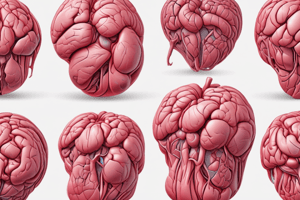Podcast
Questions and Answers
What occurs in the brain during a stroke?
What occurs in the brain during a stroke?
- Inflammation of the brain tissue due to infection
- Increased blood flow due to high blood pressure
- Blockage or bleeding affects blood supply to the brain (correct)
- Overproduction of nerve cells in the brain
Why is immediate medical attention critical during a stroke?
Why is immediate medical attention critical during a stroke?
- To enhance recovery through rehabilitation exercises
- To manage chronic pain in patients
- To provide long-term medication for blood pressure
- To prevent permanent damage or death (correct)
Which statement accurately describes a stroke?
Which statement accurately describes a stroke?
- It is a reversible condition with no long-term effects.
- It can result from blocked blood vessels or brain bleeding. (correct)
- It primarily causes heart-related complications.
- It is classified as a type of cancer affecting brain tissues.
Which of the following is NOT a cause of a stroke?
Which of the following is NOT a cause of a stroke?
How does a stroke relate to a heart attack?
How does a stroke relate to a heart attack?
Flashcards are hidden until you start studying
Study Notes
Stroke
- A stroke is a medical emergency caused by interrupted blood flow to the brain.
- Strokes are similar to heart attacks, but affect the brain.
- They can be caused by blocked blood vessels or bleeding in the brain.
- Prompt medical attention is vital to minimize brain damage and improve chances of survival.
Types of Stroke
- There are two primary types of strokes: ischemic and hemorrhagic.
- Ischemic strokes are the most common, accounting for approximately 80% of all strokes.
- They occur when blood flow to the brain is blocked, often due to a clot.
- Hemorrhagic strokes happen when blood vessels in or around the brain rupture, causing bleeding.
Hemorrhagic Stroke Subtypes
- Intracerebral hemorrhage: Bleeding occurs inside the brain when a blood vessel tears, applying pressure on surrounding brain tissue.
- Subarachnoid hemorrhage: Bleeding occurs in the subarachnoid space, which is located between two layers of brain coverings (meninges).
- This bleeding can happen when blood vessels passing through the arachnoid membrane are damaged.
Symptoms of Stroke
- Stroke symptoms can affect one or more of the following:
- One-sided weakness or paralysis
- Difficulty speaking or loss of speech (aphasia)
- Slurred or incomprehensible speech (dysarthria)
- Loss of muscle control on one side of the face
- Partial or complete loss of one or more senses (vision, hearing, smell, taste, touch)
Studying That Suits You
Use AI to generate personalized quizzes and flashcards to suit your learning preferences.




